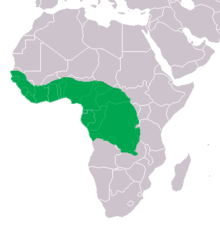Mecistops
| Mecistops | |
|---|---|

| |
| West African slender-snouted crocodile | |

| |
| Central African slender-snouted crocodile | |
| Scientific classification | |
| Domain: | Eukaryota |
| Kingdom: | Animalia |
| Phylum: | Chordata |
| Class: | Reptilia |
| Clade: | Archosauromorpha |
| Clade: | Archosauriformes |
| Order: | Crocodilia |
| Family: | Crocodylidae |
| Subfamily: | Osteolaeminae |
| Genus: | Mecistops Gray, 1844 |
| Species | |
| |

| |
| Range map | |
Mecistops is a genus of crocodiles, the slender-snouted crocodiles, native to sub-Saharan Africa.
Taxonomy and etymology
Traditionally placed in
Phylogeny
The cladogram below is based on two studies that combined morphological and molecular (DNA sequencing) data.[8][9] (Note that most morphological analyses find a closer relationship between Euthecodon and Brochuchus.[10])
Crocodylidae
|
| ||||||||||||||||||||||||||||||||||||||||||||||||||||||||||||||||||||||||||||||||||||||||||||||||||||||||||||||||||||||||||||||||||||
| (crown group) |
Alternatively, other
Crocodylidae
|
|
Paleoafrican Crocodylus Neotropical Crocodylus Indo-Pacific Crocodylus | ||||||||||||||||||||||||||||||||||||||||||||||||||||||||||||||||||||||||||||||||||||||||||||||||||||||||||||||||||||||||||||||
Extant Species
Etymology
The
Description
Slender-snouted crocodiles are native to freshwater habitats in central and western Africa. They prefer highly vegetated bodies of water to hide from prey and potential predators. They are medium-sized crocodiles, typically slightly smaller than the Nile crocodile, but are larger than several other species of crocodilians. Adults are typically about 2.5 m (8.2 ft) long, but have been known to reach 4.2 m (14 ft).[11][12] They weigh between 125 and 325 kg (276 and 717 lb).[13][14] Males are significantly larger than females. They have a slender snout used for catching prey, hence their name. They are incredibly shy and adversely impacted by human disturbance.
Behavior

The diet of the slender-snouted crocodile consists mainly of
Slender-snouted crocodiles lay an average of 16 (minimum 13, maximum 27) very large eggs (relative to body size) about a week after completion of the mound nest. The nests are constructed out of decaying vegetation.
This genus has good hearing, eyesight, and smell. Throughout the body of crocodiles, sensory pits are present, which have nerve terminals inside. The two types of these sensory pits are integumentary sense organs that cover the body and papillae that cover the head, primarily around the snout. When under water, crocodile have a “third eyelid” called a nictitating membrane, which is present in many other reptiles, but is unique in crocodiles because it is semitransparent and acts as goggles to improve eyesight when hunting and prevents eye damage. Crocodiles are able to make certain sounds, especially juveniles. Hatchling crocodiles are able to indicate when they will hatch by making a vocalization that can be heard by the mother. Crocodiles can make coughing, hissing, and bellowing vocalizations usually when feeling threatened.
Conservation
Both species in the genus have been studied very little, in part due to their remote habitat. However, M. cataphractus (when it contained both the West African and Central African populations) has been classified as
References
- ^ PMID 34567843.
- PMID 16495085.
- PMID 20195356.
- PMID 21459152.
- S2CID 85103427.
- ^ PMID 24335982.
- ^ PMID 30486023.
- PMID 30051855.
- PMID 33907305.
- ^ .
- ^ WAZA: Crocodylus cataphractus Archived 2016-10-09 at the Wayback Machine. Retrieved 18 January 2016.
- ^ Crocodilians, Natural History & Conservation: Crocodylus/Mecistops cataphractus. Retrieved 18 January 2016.
- ^ African Slender-Snouted Crocodile | The Maryland Zoo in Baltimore. Marylandzoo.org. Retrieved on 2014-05-07.
- ^ Slender-Snouted Crocodile | San Diego Zoo Animals. Sandiegozoo.org. Retrieved on 2014-05-07.
- ISBN 9782880326012.
- S2CID 23596287.

